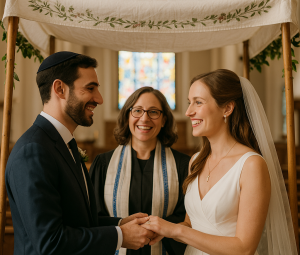Jackie Mason famously joked, “My synagogue is so Reform, the rabbi is a gentile.” Now, with the Reconstructionist Rabbinical College (RRC) recently deciding to admit students whose partners are non-Jews, and to ordain current students with non-Jewish partners, Mason’s joke is approaching reality. And the “ever-dying people” must ask their timeless question: is this good for the Jews?
North American Jews have faced this sort of situation before. In 1873, Rabbi Felix Adler, son of and heir apparent to Reform Rabbi Samuel Adler, gave an address at Temple Emanu-El in New York. Called “Judaism of the Future,” it omitted any mention of God, instead arguing that Jews should lead the way toward a universal religion founded on moral principles.
Facing a mix of protest and support, Rabbi Felix Adler founded the Society for Ethical Culture in 1877 – a clear move away from Jewish particularism, as his new society welcomed gentiles by removing all Judaic liturgy and rituals.
Some years later, Reform Rabbi Charles Fleischer began to take his Boston congregation, Adath Israel, in a similar direction. In 1900, he attempted to move the traditional Saturday morning services to Sunday. In 1911, after many fights with the synagogue’s board of trustees, he resigned from Adath Israel and founded the Sunday Commons, an ecumenical, non-denominational congregation that combined Reform Judaism with liberal Protestantism to create a progressive and humanistic religion dedicated to fostering “enlightened citizenship.” In 1919, he put the icing on his assimilationist wedding cake, marrying Mabel R. Leslie, a Presbyterian.
But unlike rabbis Adler and Fleischer, intermarried rabbis today are not using their professional roles as Jewish leaders to diminish Jewish particularism. They are not asking their congregants to accept the divinity of Jesus, Mohammed or Buddha. As long as they preach and profess Judaism from the pulpit, they are fulfilling their rabbinical duties.
The families of intermarried rabbis may encounter some difficulties raising their children, as all intermarried families do when faith is important to one or both parents. Even some who support the Reconstructionist college’s decision may wonder why a Jew dedicated to the rabbinate would choose to date outside the faith, or why a non-Jew willing to marry a rabbi would not be willing to convert to Judaism. But these are questions for their therapists.
The Reconstructionist movement has always been on the cutting edge in addressing these questions. In 1935, the movement’s founder, Rabbi Mordecai Kaplan, defined Judaism as an evolving religious civilization that needed to be reconstructed in every age and context. He famously suggested that Halachah, Jewish law, be given “a vote, but not a veto.” That flexible motto allows for progressive adaptation that remains true to the spirit of Jewish tradition, and, by extension, Jewish particularism. Ordaining women, allowing same-sex marriage between Jews, and accepting Jews of patrilineal descent may have flouted Halachah, but these changes clearly enhanced the vitality, and the numeric strength, of the Jewish community.
Rabbi Kaplan was not strictly a theist, prompting some to joke that Reconstructionist Jews believe in “at most one God.” Political scientist Charles Liebman once quipped that 70 per cent of American Jews are Reconstructionist “and they don’t know it.” Rabbi Kaplan’s motto simply codified a reality: modern Jews prefer a pick-and-choose style Judaism to a legalistic one. Reconstructionism mimicked and legitimated behaviour that was already in place.
In that sense, the decision to allow intermarried rabbis is true to the Reconstructionist spirit, for intermarriage is a clearly established reality of Diaspora Jewish life. Thus, the Reconstructionist approach is: let us use intermarriage, rather than bend to its will. Let intermarriage be a force for particularism, rather than universalism, by making more room in our unique community for those who want to embrace its uniqueness.
David Weinfeld teaches American Studies at the University of Toronto.






